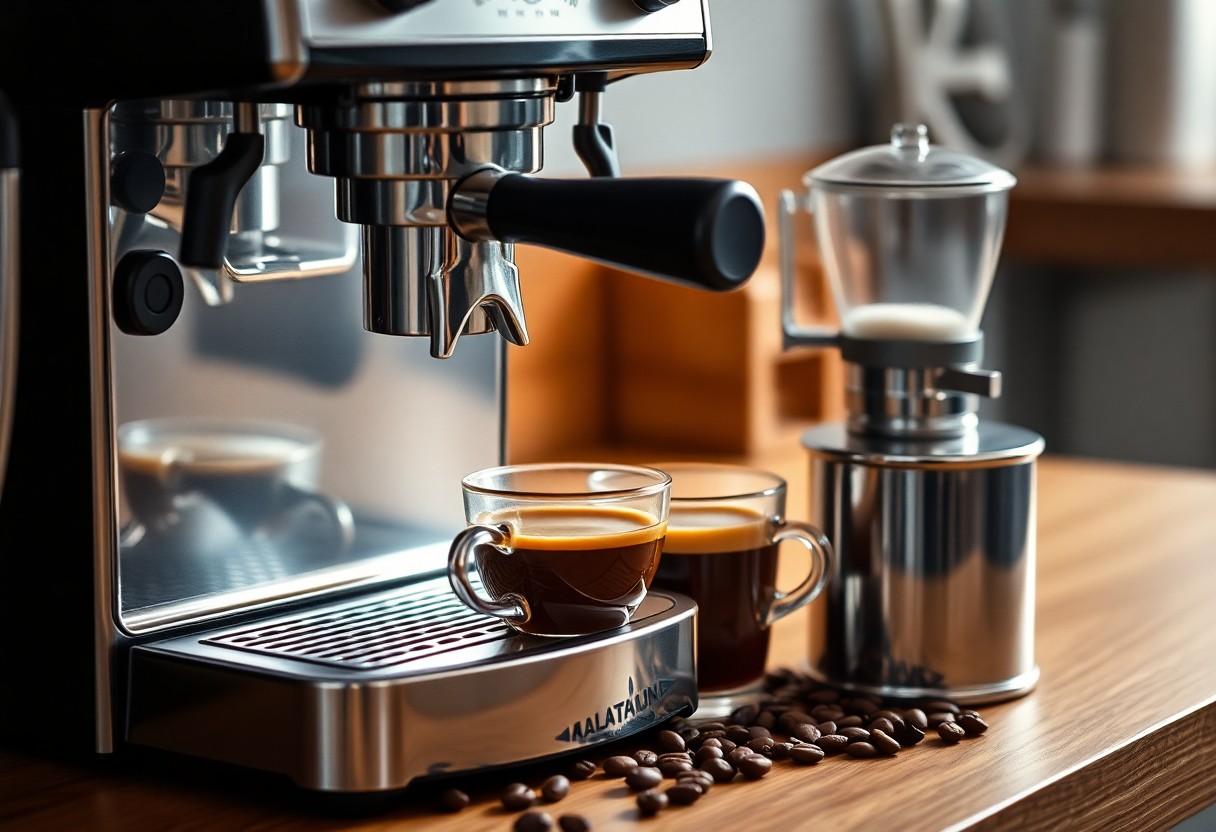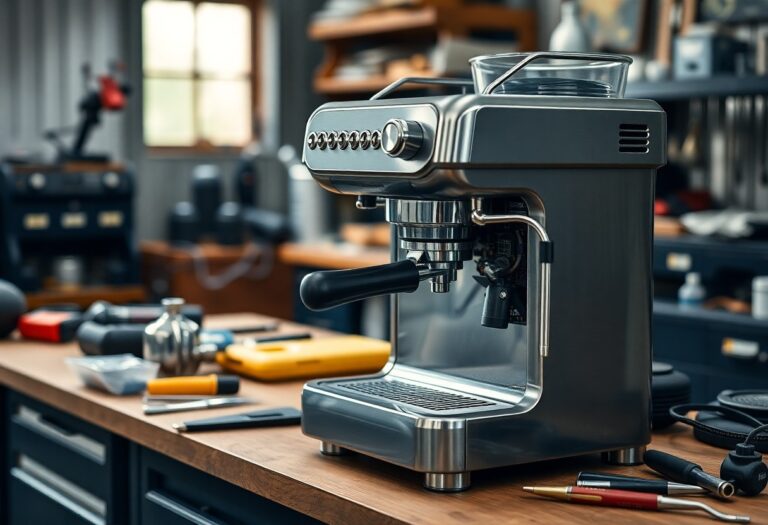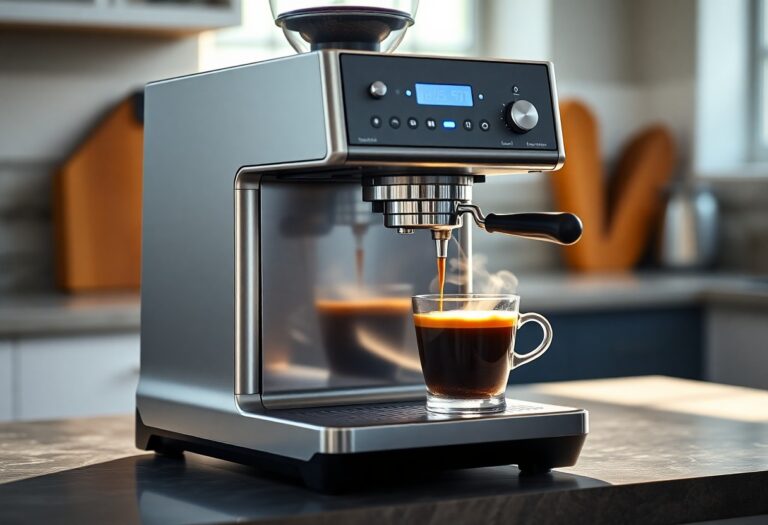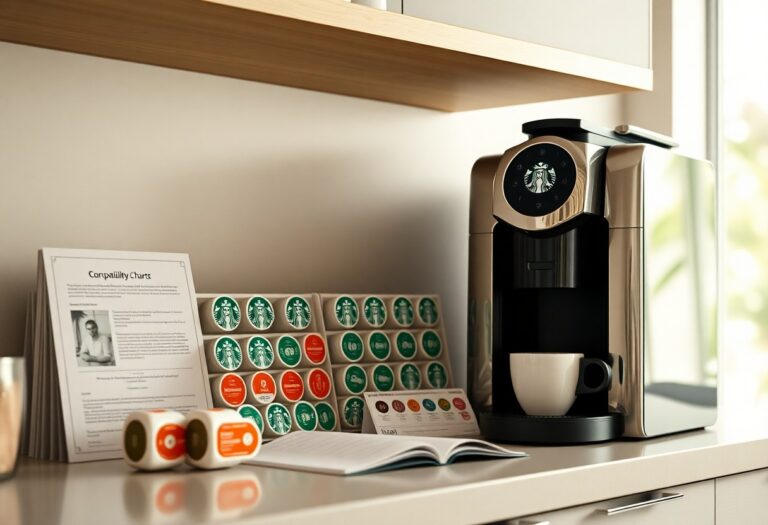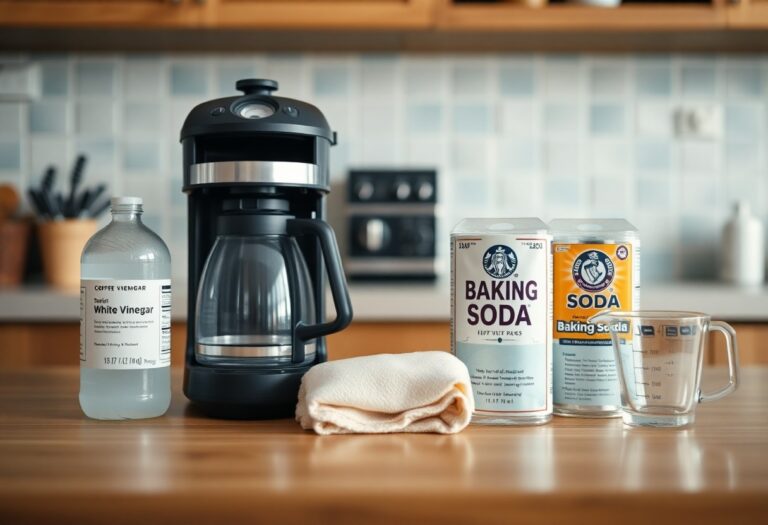What is a Semi-Automatic Coffee Machine – Manual Control
There’s a world of difference when it comes to brewing coffee, and you might find that a semi-automatic coffee machine offers the perfect balance between control and convenience. In this blog post, you’ll discover how these machines give you manual control over your brewing process, allowing you to adjust variables like water temperature and extraction time. With a semi-automatic machine, you have the power to craft your ideal cup, elevating your coffee experience while still enjoying the taste and aroma you love. Let’s explore how this blend of technology and technique can enhance your morning routine.
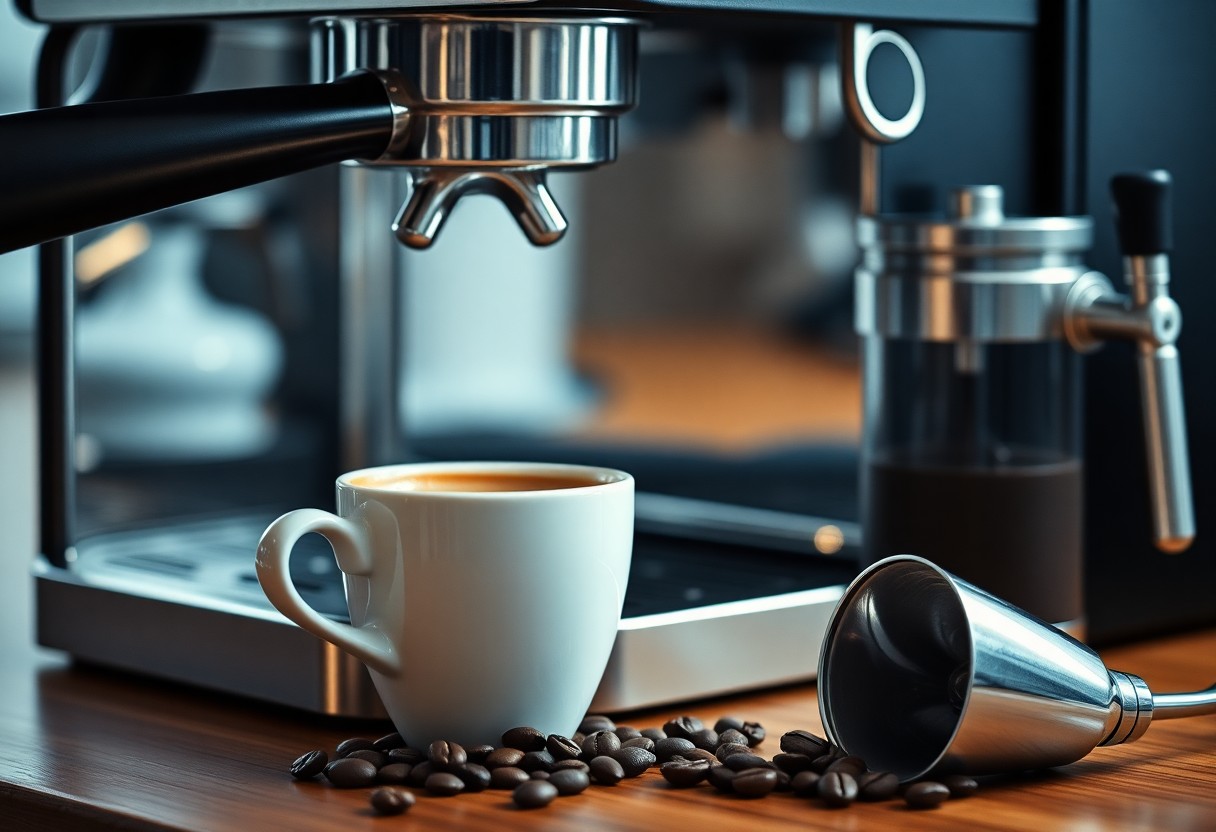
Key Takeaways:
- Semi-automatic coffee machines provide a balance between automation and manual control, allowing users to customize their brewing process.
- These machines require users to grind coffee beans, tamp them, and control the extraction time for the perfect shot of espresso.
- Users have the freedom to adjust variables such as water temperature and pressure, which impacts the flavor profile of the coffee.
- They often feature a built-in steam wand for frothing milk, enabling the creation of lattes and cappuccinos.
- While offering more control, semi-automatic machines require practice and understanding of brewing techniques for optimal results.
The Anatomy of a Semi-Automatic Coffee Machine
A semi-automatic coffee machine is a marvel of engineering designed to give you control over the brewing process. It combines various important components such as the water reservoir, pump, heating element, and group head to ensure optimal extraction. Each part plays a pivotal role in delivering the perfect espresso shot. To dive deeper into the various options available, check out Types of Espresso Machines: Manual vs. Semi-Automatic ….
Key Components and Their Functions
The key components of a semi-automatic coffee machine include the portafilter, which holds the coffee grounds; the pump, responsible for generating pressure; the boiler, which heats the water; and the group head, where water flows through the coffee. This setup allows for consistent extraction and rich flavor, giving you control over each shot. Understanding these parts will help you troubleshoot issues or optimize your brew.
How Manual Control Enhances Brewing Precision
Manual control in a semi-automatic machine gives you the ability to fine-tune various aspects of brewing, such as the grind size, tamp pressure, and water temperature. This level of control means you can adjust your process based on the coffee beans you’re using or personal taste preferences. Each variable you manipulate can significantly affect the final cup, allowing for a more customized and refined flavor profile.
Having manual control means you can experiment with different brewing techniques and parameters. For instance, varying the grind size can yield different extraction rates; a finer grind may extract more flavor oils, while a coarser grind could lead to a cleaner taste. By adjusting the water temperature, you can extract different flavor notes, affecting the balance of acidity and sweetness in the coffee. Such precision not only enhances your understanding of the brewing process but also allows you to perfect your ideal cup, catering to your unique taste preferences.
Mastering the Brew: Techniques for the Perfect Cup
Achieving a perfect cup of coffee involves more than just the right machine; mastering specific brewing techniques can elevate your experience. Each element—from grind size to water temperature—plays a vital role in the flavor profile of your coffee. You have the power to manipulate these variables using a semi-automatic coffee machine, allowing you to refine your espresso and enhance its nuances. Practice and experimentation will hone your skills, ultimately leading you to your ideal cup.
Grind Size and Its Impact on Extraction
The grind size significantly influences the extraction process and overall flavor of your coffee. A fine grind increases surface area, promoting faster extraction and potentially bitter notes. Conversely, a coarse grind reduces extraction time, leading to a milder flavor. Striking the right balance is key—experiment with various sizes to find the perfect match for your taste preferences and brewing time.
Understanding Water Temperature and Pressure
Water temperature and pressure are critical for optimal espresso extraction. The ideal brewing temperature ranges between 90°C to 96°C (194°F to 205°F). A low temperature will under-extract flavors, while a high temperature can lead to bitterness. Pressure should be set around 9 bars to effectively force water through the coffee grounds while maintaining flavor integrity.
Temperatures and Pressures
| Parameter | Ideal Range |
|---|---|
| Temperature | 90°C – 96°C (194°F – 205°F) |
| Pressure | 9 bars |
Paying close attention to water temperature allows your coffee to extract the right flavors while avoiding undesirable characteristics. Too cool, and the coffee won’t fully develop its taste; too hot, and you risk over-extraction, yielding bitterness. Fine-tuning these aspects will bring out the delicate flavors and aromas that make each brew unique, enhancing your overall coffee-drinking experience.
Temperature Insights
| Temperature | Effect |
|---|---|
| Below 90°C | Under-extraction, sour taste |
| Above 96°C | Over-extraction, bitter notes |
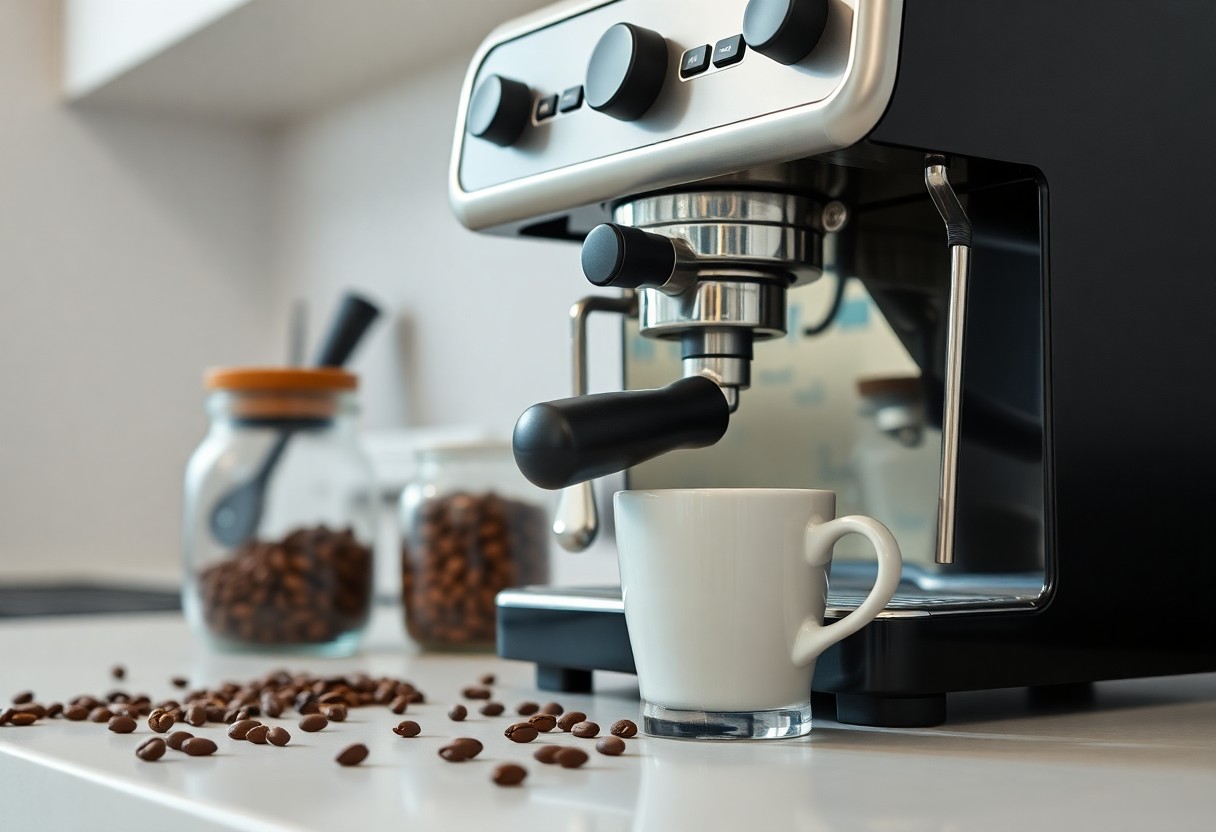
Common Pitfalls: Mistakes to Avoid with Semi-Automatic Machines
Using a semi-automatic coffee machine offers incredible flexibility, but it can lead to some common pitfalls if you’re not careful. Over-extracting or under-extracting coffee can spoil your brew, while neglecting regular maintenance will result in subpar performance and flavor. For a deeper understanding of these issues, check out the Differences Between Espresso Machines.
Over-Extracting vs. Under-Extracting Coffee
Achieving the right extraction is about finding balance; over-extracting leads to bitterness, while under-extracting results in sour, underwhelming flavors. You should aim for a brew time of around 25-30 seconds for a double shot, adjusting grind size and tamping pressure as necessary to avoid these extremes.
Neglecting Machine Maintenance
Paying attention to machine maintenance is crucial for consistent performance. A clean machine not only prolongs its lifespan but also ensures that your coffee tastes fresh and vibrant. Regularly descaling your semi-automatic coffee machine will prevent mineral buildup that can affect pressure and flavor. Additionally, keep the ports and filters clean to avoid any residue that may transfer unwanted flavors into your brew. Schedule regular maintenance intervals, ideally every few months, to keep it running smoothly and producing consistently great coffee.
The Barista’s Perspective: Insights from Coffee Professionals
Baristas often view semi-automatic machines as the perfect blend of artistry and technology. They appreciate the direct involvement these machines offer, allowing for variability in extraction that can cater to personal preferences and unique bean profiles. This hands-on approach enables baristas to refine their craft, experimenting with factors such as grind size, tamp pressure, and brew temperature to achieve the ultimate coffee experience for their customers.
Personal Preferences in Manual Brewing
Each barista has distinct preferences when it comes to manual brewing, shaped by their training and experiences. Some prioritize precision and consistency, meticulously measuring each variable to extract the best flavors. Others enjoy the freedom of experimentation, often adjusting techniques to highlight specific notes in specialty coffees. This personal touch enhances the connection between the barista and the beverage, making each cup a unique reflection of their expertise.
The Role of Semi-Automatic Machines in Coffee Culture
Semi-automatic machines have significantly influenced coffee culture by empowering both amateur and seasoned baristas to create café-quality brews at home. Their blend of control and convenience appeals to coffee enthusiasts looking for an engaging brewing experience. With features like programmable settings and manual overrides, you can explore your creativity while pulling shots that rival those of professional shops.
Moreover, semi-automatic machines foster a vibrant community, encouraging coffee lovers to share techniques, recipes, and experiences. Many coffee shops featuring these machines host workshops and cuppings, promoting education and appreciation for the craft. They also inspire a new generation of home brewers to explore the complexities of coffee, actively participating in a culture that values quality and personalization. This shift contributes to a more informed consumer base, driving demand for high-quality beans and sustainable practices within the coffee industry.
The Future of Manual Espresso: Trends and Innovations
The future of manual espresso is bright, with a growing emphasis on personalized brewing experiences. As coffee enthusiasts seek the perfect cup, innovations are focusing on enhancing flavor extraction while ensuring user control. This evolving landscape invites you to explore artisanal practices, advanced techniques, and community-driven movements, all aiming to elevate your espresso journey.
Emerging Technologies in Brewing
Innovations in brewing technologies are revolutionizing the way you experience espresso. Smart, app-connected machines now allow for precision brewing and recipe customization right from your mobile device. You’ll find features like temperature control and pressure profiling, enabling you to experiment and fine-tune each shot according to your unique preferences. It’s not just about convenience; it’s about enhancing the quality of your brew.
Sustainability Practices in Coffee Production
With a heightened awareness of environmental impact, sustainability in coffee production is becoming paramount. You can now choose brands prioritizing eco-friendly practices, such as water conservation, minimal fertilizer use, and organic farming methods. These practices not only ensure better quality beans but also promote the health of ecosystems and communities involved in coffee cultivation.
Engaging with sustainable coffee practices can transform both your brewing experience and environmental footprint. For instance, consider sourcing beans from certified organic farms that use regenerative agriculture, which maintains soil health and biodiversity. Additionally, many coffee brands are adopting direct trade models, which guarantee fair wages for farmers and foster long-term relationships. By choosing such options, your espresso ritual not only delights your palate but also supports ethical standards and ecological balance in the coffee industry.
Summing up
Ultimately, a semi-automatic coffee machine offers you the perfect blend of technology and personal touch, allowing you to control each aspect of your brewing process. With manual features, such as adjusting water flow and extraction time, you can tailor each cup to your taste preferences. This type of machine empowers you to explore the nuances of espresso making while still benefiting from the convenience of automation, making it an excellent choice for both beginners and experienced enthusiasts alike.
FAQ
Q: What is a semi-automatic coffee machine with manual control?
A: A semi-automatic coffee machine with manual control allows users to have greater involvement in the brewing process. Unlike fully automatic machines, which handle every step of coffee preparation, semi-automatic machines let users manually control the water flow and brewing time. This level of control enables coffee enthusiasts to experiment with different variables, resulting in customized brews based on personal preference.
Q: What are the main features of a semi-automatic coffee machine?
A: Semi-automatic coffee machines typically feature a built-in water reservoir, a portafilter for holding the coffee grounds, a steam wand for frothing milk, and adjustable settings for both water temperature and brew time. Users can also fine-tune the grind size of the coffee beans and the tamping pressure, providing an opportunity for tailored results in texture and flavor.
Q: How does manual control enhance the coffee-making experience?
A: Manual control enhances the coffee-making experience by allowing users to personalize each cup. Baristas can modify variables like brew time and pressure to influence the extraction process, leading to distinct flavors. This engagement not only leads to a more satisfying brewing experience but also promotes a deeper understanding of coffee-making techniques and principles.
Q: Are semi-automatic coffee machines suitable for beginners?
A: Yes, semi-automatic coffee machines can be suitable for beginners, although they may require a bit of a learning curve. While these machines provide more control over the brewing process, they still maintain some automation features, making them manageable for novice users. With practice and exploration, beginners can gain valuable skills while enjoying their coffee-making journey.
Q: What are the advantages of choosing a semi-automatic coffee machine over other types?
A: The advantages of semi-automatic coffee machines include greater control over brewing parameters, the ability to experiment with various techniques, and the potential for greater quality in the final product. Additionally, they often offer a balance between automation and manual input, making them adaptable for both casual drinkers and serious enthusiasts. They also tend to be more versatile in terms of the variety of coffee drinks that can be prepared.

